The violin is a beautiful, complex, and delicate instrument. Whilst being an admirable piece of craftsmanship all on its own the violin has been cleverly designed to produce the warm, rich tone it is celebrated for. It is useful for violin players to know the features of their instrument as this will aid the maintenance and upkeep of the violin. It may also guide them in knowing what sort of violin to buy.
In this post, we will outline the different parts of the violin, provide a detailed explanation of each feature and how it contributes to the function of the instrument. Let’s get started.
Anatomy of the Violin
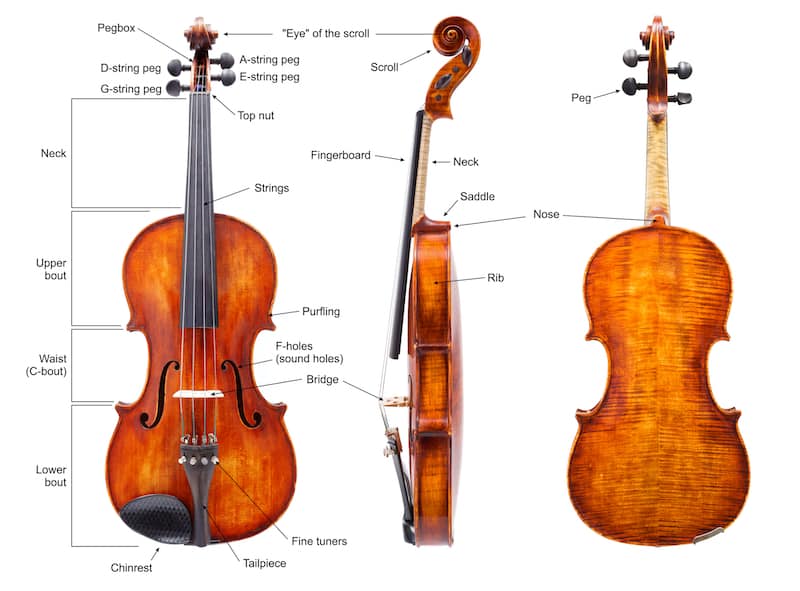
Pegbox
The Pegbox is the section found at the very top of the violin and is where the strings are attached at one end of the violin.
The Scroll
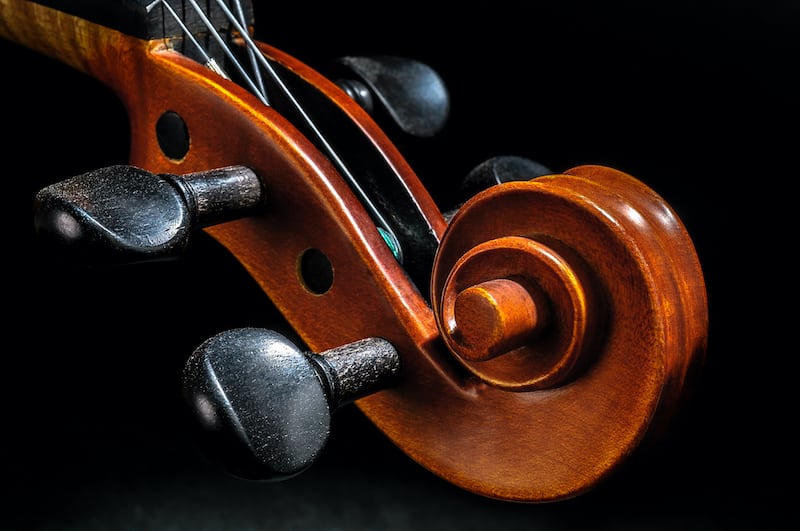
The Scroll is the spiral-like shape carved into the wood and is found at the topmost point of the violin.
Its purpose is purely decorative and has zero effect on the overall sound or tone of the instrument.
The scroll provided violin makers (luthiers) with a chance to display their carving skills and so some scrolls have been whittled into elaborate shapes such as animal or human heads.
Tuning Pegs
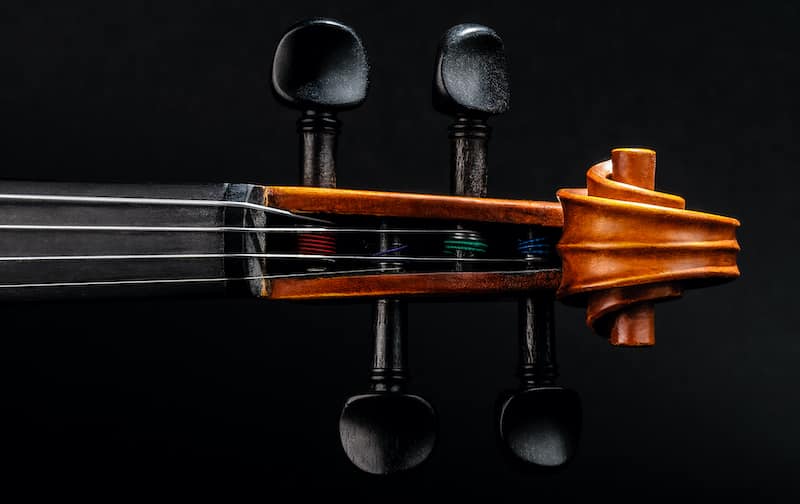
Underneath the scroll is the pegbox where you’ll find the four Tuning Pegs that correspond to the four strings on the violin.
When a peg is turned it will adjust the tautness of the string and therefore the pitch of the string.
When a peg is turned clockwise, it will tighten the string and therefore sharpen the pitch.
The opposite is also true, when a tuning peg is turned anti-clockwise, it will loosen the string and therefore flatten the pitch.
It’s important to mention that when tightening your tuning pegs if you turn it too far or too fast as this can cause a string to snap as they get too tight.
Turning the pegs slowly is recommended for this delicate mechanism and for small adjustments you should use the fine tuners (which we’ll cover later in this article).
As well as being an essential part of tuning a violin, the pegs are also key for replacing the strings on your instrument.
The Neck

The next section of the violin is called the Neck which is the slender piece of wood (typically maple) that attaches the body of the violin to the pegbox and the scroll at the top.
It sits underneath the fingerboard and adds stability to the slimmest section of the instrument.
While playing, violinists will rest their thumb on the neck, which helps to anchor their hand as they move up and down the strings.
Fingerboard
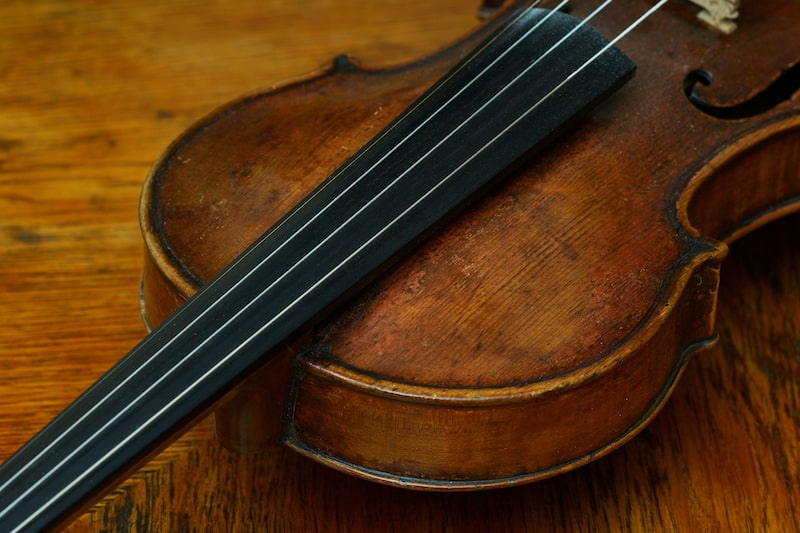
The Fingerboard is a black piece of wood that sits on top of the neck and below the strings.
Often made out of ebony
It follows the course of the strings, from the neck to the main body.
It is not characterized by frets, like on a guitar.
It is smooth in texture and slightly arch-shaped to assist violinists in bowing on one string at a time without hitting the other strings unintentionally.
When violinists play they press the strings down onto the fingerboard to create different notes and pitches.
Strings
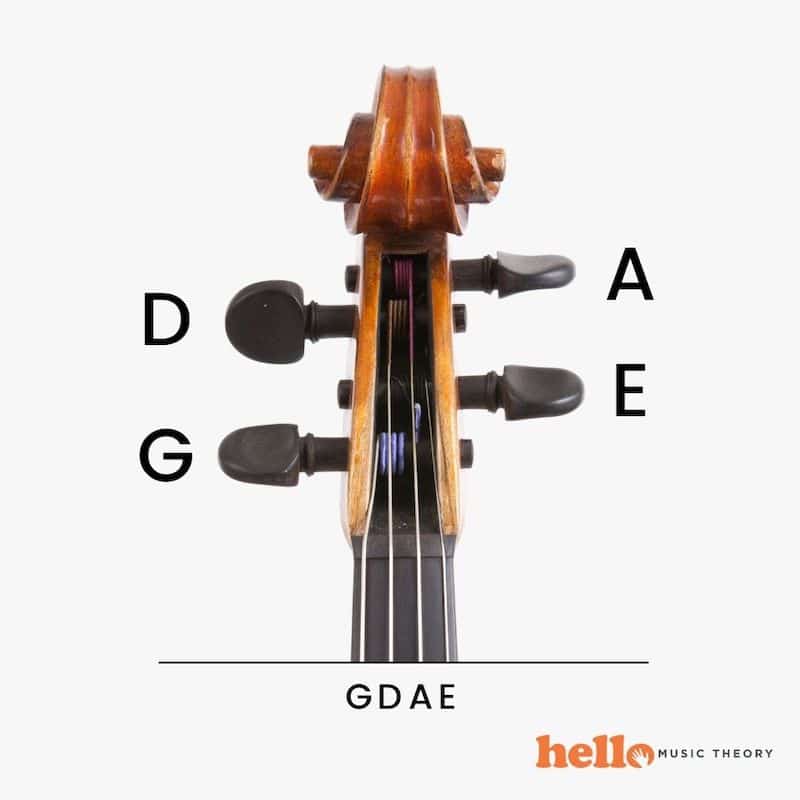
A violin has four Strings: G, D, A and E, with each string being named to match the notes that they are tuned to. Starting with the lowest (G) and rising by a musical interval of a fifth each time (D, A and E).
These notes will sound if a violinist plays the string without pressing their fingers down, which is also described as playing an open string.
Strings are attached at the top of the violin in the pegbox (where they’re tightened and loosened) and to the tailpiece near the bass of the instrument.
Nowadays, violin strings tend to be made from steel or nylon but, in the past they were typically made from animal intestines and were referred to as gut strings.
The Nut
The Nut is a small ridge located at the top of the fingerboard that controls the placement and height of the strings which is called the action.
The further the distance between the strings to the fingerboard is, the higher the action is, and vice versa, the smaller the distance, the lower the action is.
As well as determining the action, the grooves in the nut allow for the strings to be correctly spaced and to prevent them from slipping out of place.
The nut is a useful guide for violinists when they need to replace a a string.
The Body
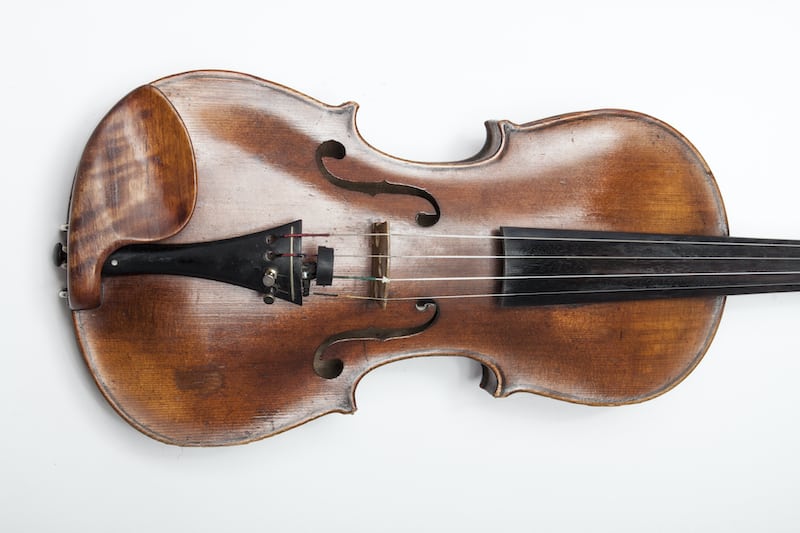
The Body of the violin is the largest surface area of the instrument and makes up the unique, 3D, figure-of-eight shape and its hollow interior.
The body of the violin is made up of three pieces: the front plate or ‘belly’ and the backplate with these two pieces being connected by the sides or ‘ribs’ of the violin.
The hollow interior creates amplification and resonance when the violin is played.
The ‘waist’ section of the figure of eight or body allows for the bow to glide over strings without getting stuck or hitting the side of the violin.
The Bridge
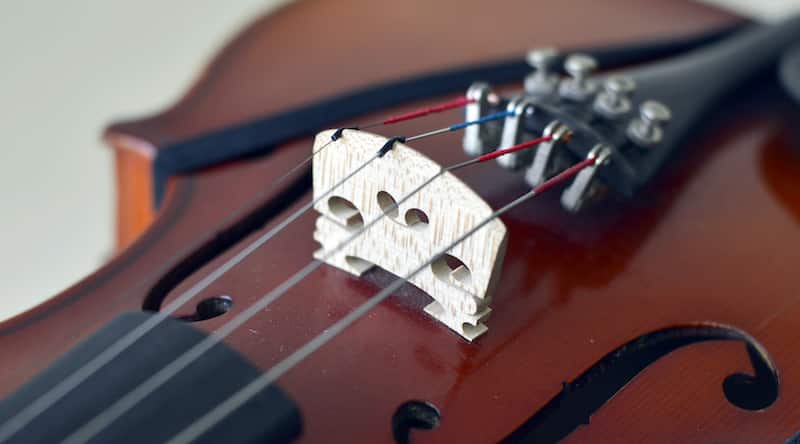
The Bridge of the violin is a small, arch-shaped piece of wood that has many functions and plays an important role in sound production and quality of the instrument’s tone.
It is located in the middle of the body and supports the four strings placement with in-built grooves to hold them up and keep them taught.
When the violin strings are played the bridge carries the vibrations into the hollow body of the violin, enabling sound to resonate out.
The E string (the thinnest string) often has a plastic protector on it to prevent it from cutting into the bridge.
Different violins have varying degrees of curve on their bridge, depending on their function.
A flatter shaped bridge will make playing more than one string at once easier (called double-stopping), but on the flip side make it more difficult to play one string on its own.
This is why fiddles often have flatter bridges and classical violins employ a more curved shape.
The Tailpiece
The Tailpiece is a piece of wood found on the body of the violin that functions to secure the strings underneath the bridge so that they remained anchors at one end.
It contains slots for each string to sit firmly into and is also where the micro tuners are situated (which we’ll look at later in this article).
It is attached to the bottom side of the instrument by an end button/endpin, which is typically a black mechanism to ensure that the strings stay tight and in place.
The F Holes
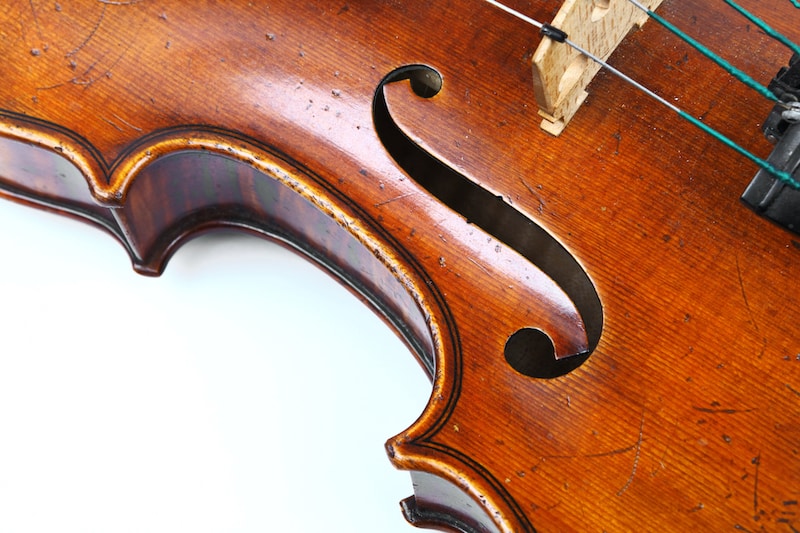
The F-holes, or soundholes as they are sometimes referred to are the ‘F’ shapes that have been cut into the body of the violin either side of the bridge.
After the strings have been played and the vibrations travel into the hollow body of the violin, the F holes function to release and project the sound out.
You’ll also see F holes on other stringed instruments like the viola, cello, double bass and even some semi-acoustic guitars.
The Sound Post
The Sound Post is not easily spotted as it is located inside the violin underneath the bridge.
If you peek through the F holes, you might be able to see the small, unvarnished post which connects the front and back plates and additionally supports the structure of the instrument.
It assists in carrying vibrations to the back of the violin which ultimately helps with the tone and projection of sound.
It’s held up by the tension of the strings so you should always be very careful when replacing strings that it doesn’t fall over as getting it back up is very tricky and requires a specialist to get it back up.
Fine Tuners
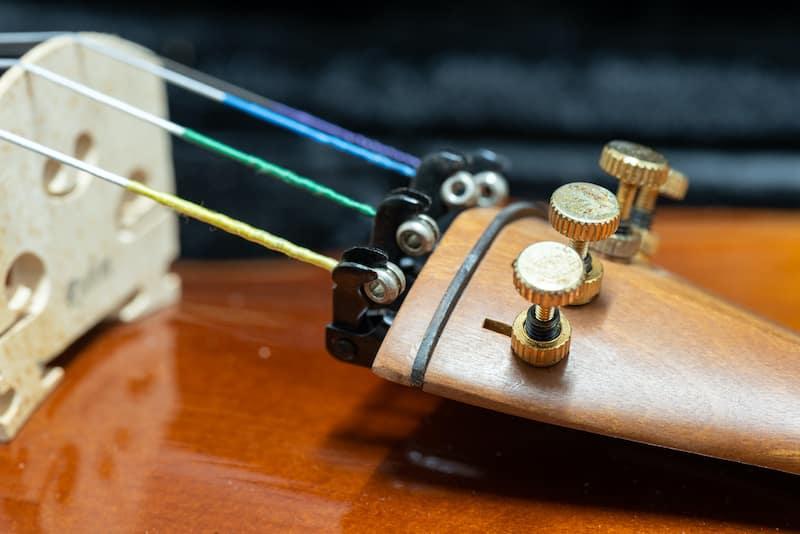
Fine Tuners are a useful feature of the tailpiece that function to tune strings by making small, micro-adjustments to the strings tension.
They do not hold the same capacity as the tuning pegs for altering pitch, but can be useful for making small corrections if a string is slightly flat or sharp.
Some violins do not come with four fine tuners and may only have one for the E string, in which case the tuning pegs will be relied upon completely for tuning these strings.
Chin Rest
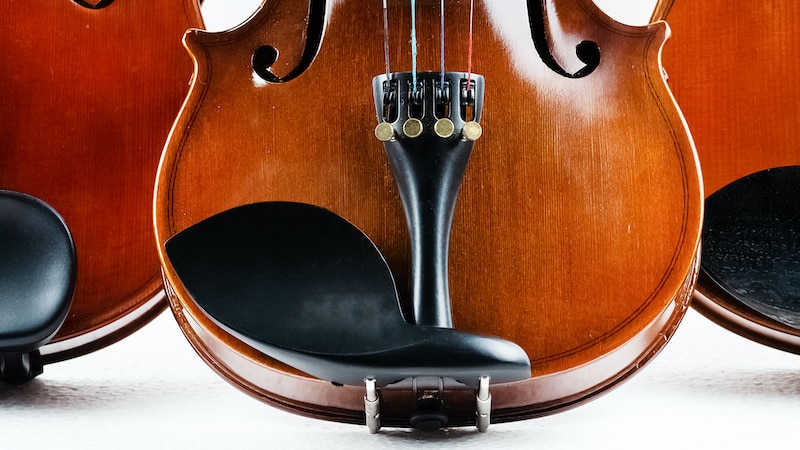
The Chin Rest has been aptly named, as it provides a space for the violinists’ chin to rest on as they play.
This is important as it frees up the left hand for finger work and means that the violin is naturally held up and supported.
Most violinists also make use of a shoulder rest (a device that clips onto the bottom of the violin, and cushions its contact with the shoulder) for maximum comfort and support, but this is not necessarily essential.
The Bow

The Bow is separate to the violin, but a crucial tool for producing the sound on the instrument.
Violinists can produce sound without the bow which is known as playing pizzicato and is achieved by plucking the strings with the fingertips.
However, it’s more common to play with a bow, known as playing arco to create the rich timbre of the violin.
The bow consists of a long piece of wood attached to either horse or synthetic hair with one violin bow often having as many as 160 – 180 individual hairs.
At the base of the bow is the frog, which is where violinists grip the bow and the hair is attached.
To allow the bow hair to grip the strings, it’s rubbed with Rosin – a type of resin from pine – that creates the friction needed for it to produce sound as it’s dragged across the string.
This friction caused by the bow gliding over the string is what produces the vibrations that create the sound of the violin.
Summing Up The Violin’s Anatomy
That is it for this article, explaining the different parts of the violin and what they do.
We hope it has given you a better understanding of the violin’s makeup and design.
Violins are very sensitive and delicate instruments and their different parts should be precisely in place for it to sound just right.
The materials used can also be very important because the sound resonates through the type of wood that has been used and can mean that one violin will sound completely different to another.
If you are looking to buy a violin it is a good idea to try out lots of different ones until you find one that sounds and feels good to you.

